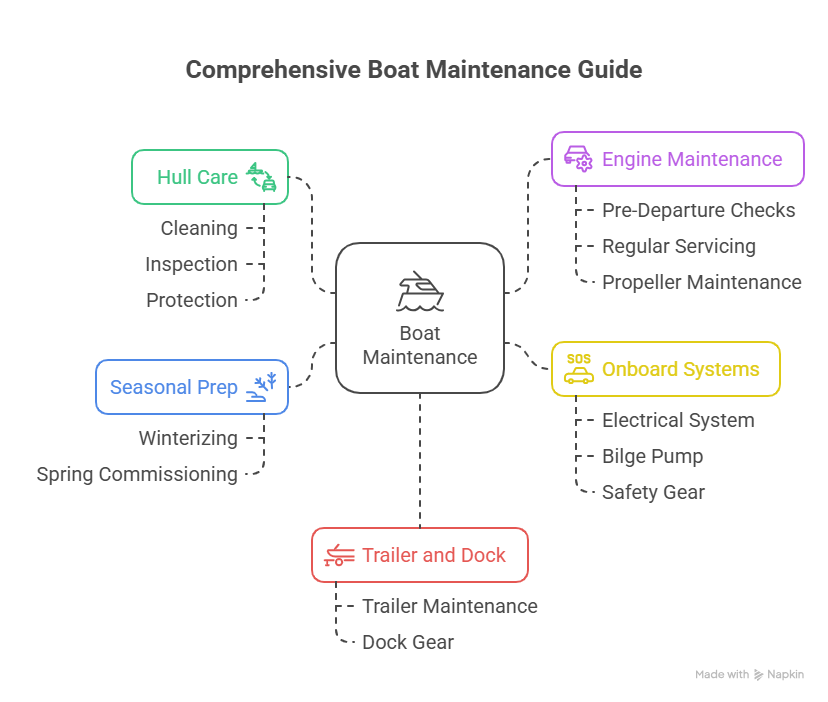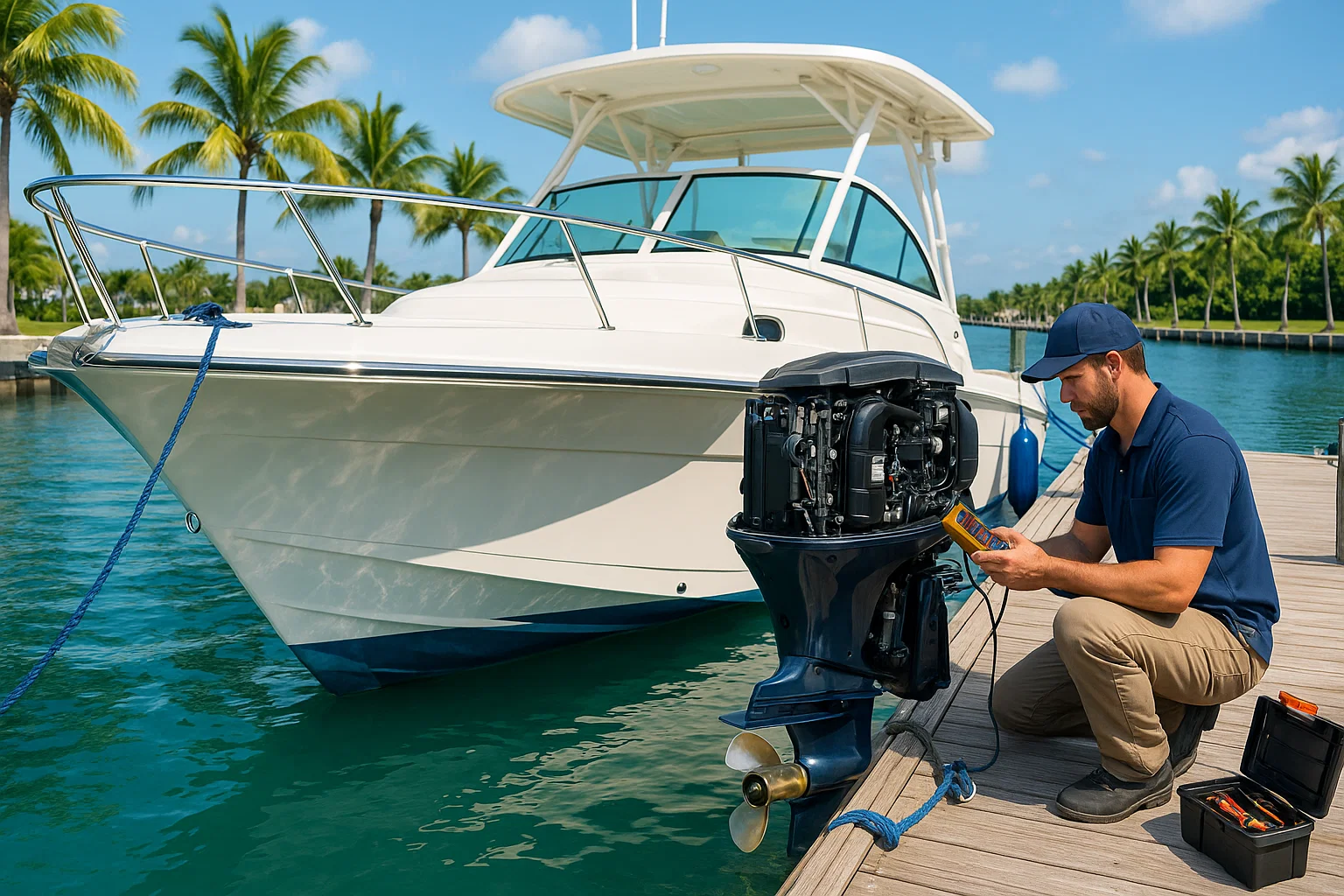Boat Care Tips: 15 Years of Keeping Vessels Shipshape in South Florida
I’ve been wrenching on boats for 15 years, mostly in Miami and Fort Lauderdale’s salty marinas, and I’ve learned one thing: a well-maintained boat means more time on the water and less time cursing at the dock. Last July, a buddy named Carlos at Dinner Key Marina had his Sea Ray 230 stall off Key Biscayne—turned out to be a clogged fuel filter from skipping maintenance. Cost him $300 to fix, plus a ruined weekend. That’s why I’m sharing my go-to boat care tips—stuff I’ve picked up from years of fixing other people’s mistakes. These aren’t just chores; they’re your ticket to a reliable, safe vessel that’s always ready for adventure.
Why Do Boat Care Tips Matter?
Boat ownership isn’t just about cruising; it’s about protecting a big investment. A solid maintenance routine keeps your vessel running smoothly, saves you from $2,000 repair bills, and ensures you’re not stranded when the fish are biting. I’ve seen too many boats limp back to Bahia Mar because owners skipped the basics. This guide covers hull care, engine checks, safety systems, seasonal prep, and trailer maintenance, all grounded in what I’ve learned keeping boats afloat in South Florida’s harsh conditions.
The Hull: Your Boat’s First Line of Defense
Your hull takes a beating from saltwater, sun, and barnacles. Keeping it clean and protected isn’t about looks—it’s about saving thousands on repairs down the line.
How Do I Keep My Hull Clean and Protected?
I wash my Boston Whaler every time I pull it out of the water, using a pH-balanced marine soap like Star brite. Salt and grime eat gelcoat, so I use a soft-bristle brush to avoid scratches. Waxing’s a must—twice a season with a quality marine wax like 3M Marine Restorer. Last summer, a client at Coconut Grove skipped waxing, and his hull’s UV damage cost $1,500 to fix. Polish stainless fittings with Flitz to stop corrosion—takes 10 minutes and keeps them shiny.
What Should I Look for During a Hull Inspection?
I scan my hull before every trip, looking for blisters, cracks, or dings. Last June, I caught a hairline crack on a client’s Grady-White 208 at Stiltsville—fixed it with a $50 gelcoat kit before it became a $2,000 problem. Blisters mean water’s sneaking in, so don’t ignore them; they might need a pro. Check thru-hulls and seacocks for leaks—had a guy last year whose leaky seacock nearly sank his Bayliner. A quick visual check saves headaches.
How Do I Prevent Marine Growth and Corrosion?
Antifouling paint’s your friend. I use ablative paint like Interlux Micron CSC—it wears off gradually, keeping barnacles at bay. Last spring, a client’s neglected bottom paint cut his fuel efficiency by 20%. For corrosion, I check sacrificial anodes (zincs) monthly—replace them at 50% erosion. On my Whaler, I swap zincs every six months; saved me $3,000 in prop shaft repairs once. These steps keep your hull solid and your boat fast.
Engine and Propulsion: Keeping the Heart Pumping
Your engine’s the core of your boat. A little attention here prevents you from waving for a tow in the middle of Biscayne Bay.
What’s the Best Pre-Departure Engine Check?
I do a five-minute check before every trip: oil level, coolant, fuel lines, and belts. Last August, I spotted a cracked fuel line on a Mercury 150 at Key Biscayne—fixed it for $75 before it stranded the owner. Always flush the engine with fresh water after saltwater runs; I use a Salt-Away kit to kill corrosion. Skipping this cost a guy $2,500 in engine repairs last season. It’s simple but non-negotiable.
How Often Should I Service My Engine?
I stick to my Yamaha’s manual—oil and filter every 100 hours or yearly. Changing oil before winter storage is key; old oil’s acidic and eats engine parts. I learned this the hard way in 2010 when I skipped it and faced a $1,200 rebuild. Replace fuel filters and the water pump impeller annually—my buddy Javier skipped his impeller, and his engine overheated, costing $800. Spark plugs go every 200 hours; I use NGK for reliability.
How Do I Maintain My Propeller?
A dinged prop kills performance. I check mine monthly for nicks or fishing line—found some wrapped around my shaft last July, took 10 minutes to clear. Remove the prop twice a season, grease the splines with marine grease like Quicksilver 2-4-C, and check for 0.003” runout with a dial gauge. A client’s bent prop vibrated his Yamaha 200’s shaft, costing $1,500 to fix. Regular checks keep you moving smoothly.
Onboard Systems: Your Safety Net
Your boat’s systems—electrical, plumbing, safety gear—are its nervous system. If they fail, you’re in trouble.
How Do I Keep My Electrical System Reliable?
Batteries are your lifeline. I check mine with a multimeter before every trip—12.6 volts is good; below 12.2 means trouble. Last month, a guy at Bahia Mar had a dead battery mid-trip; cost him $200 for a tow. Clean terminals with a wire brush to kill corrosion, and test nav lights and VHF radio. I caught frayed wiring on a client’s Sea Ray last summer—fixed it for $50 before it shorted.
Why Is My Bilge Pump So Important?
Your bilge pump keeps you afloat. I test mine monthly by lifting the float switch and flipping the helm’s manual switch—takes 30 seconds. A client’s pump failed off Stiltsville in 2024, and water hit his engine; $3,000 repair. Check hoses and clamps for cracks; I replace mine every two years with marine-grade ones. Flush freshwater tanks to avoid mold—learned that after a smelly summer in 2015.
What Safety Gear Should I Check?
Safety gear’s non-negotiable. I inspect life jackets for tears, fire extinguishers for charge, and flares for expiration dates before every season. Last June, a client’s expired flares got him a $200 fine. Keep a stocked first-aid kit and check anchor lines for chafe—I use a 3-strand nylon rode for strength. These checks take 10 minutes but can save your life.
Seasonal Prep: Winterizing and Spring Commissioning
Winterizing and commissioning right means your boat’s ready when you are, not sitting in a shop.
How Do I Winterize My Boat Properly?
Winterizing’s like tucking your boat in for a nap. I flush the engine with antifreeze and change the oil before storage—skipping this cost me $1,200 once. Fill the fuel tank to 90% with a stabilizer like Sta-Bil; I learned this from a mentor, Ray, in 2012. Drain water systems or use non-toxic antifreeze, and store canvas and electronics indoors to avoid mildew. A good cover—custom or shrink wrap—keeps weather out.
What’s the Best Way to Commission in Spring?
Spring’s about waking your boat up. I reinstall batteries, check fluids, and flush antifreeze—takes two hours. Last April, I caught a worn belt on a client’s Yamaha 250 during commissioning; saved him $500. Reinstall safety gear, verify registration, and wax the hull with 3M Marine Wax. A thorough check ensures you’re on the water, not in the shop, come May.

Trailer and Dock: Protecting Your Boat on Land
Your trailer and dock gear are as critical as your boat. A failure here can ruin your day—or your hull.
How Do I Maintain My Trailer?
I check my trailer’s tires before every trip—30 PSI for my Load Rite. Repack wheel bearings yearly; I learned this after a $600 roadside failure in 2018. Inspect the frame for rust, especially after saltwater launches, and test brake lights. Last summer, a client’s misaligned bunks scratched his hull—$800 fix. A 10-minute check keeps your boat safe on the road.
What Dock Gear Do I Need?
Dock lines and fenders save your hull. I use 5/8-inch nylon lines and inflate fenders to protect my Whaler’s beam. Check cleats for loose bolts—found a wobbly one on a client’s boat last month, fixed for $20. A wake hit a guy’s unprotected hull at Coconut Grove, costing $1,500. Quality gear’s cheap insurance.
FAQ: Common Boat Care Questions
How Often Should I Wash My Boat?
I wash mine after every saltwater trip with Star brite soap—takes 20 minutes. Skipping this lets salt eat the gelcoat, like a client’s $1,500 repair last year. Use a soft brush and microfiber towels. Wax twice a season for UV protection. Check out Star brite’s marine products at starbrite.com.
What’s the Best Antifouling Paint?
I swear by Interlux Micron CSC—ablative, keeps barnacles off. Apply every 1–2 years; cost me $200 last season. Hard paints like Pettit Vivid work for high-speed boats. Check Interlux’s guide at interlux.com for your boat type. It’s a game-changer for performance.
How Do I Check My Sacrificial Anodes?
Inspect zincs monthly—replace at 50% erosion. I use a micrometer to check; saved my prop shaft $3,000 once. Takes 5 minutes. Buy marine-grade zincs from westmarine.com. Don’t skip this—it’s your underwater metal’s lifeline.
When Should I Change My Engine Oil?
Change it every 100 hours or before winter storage. I use Yamaha 10W-30; costs $50. Skipping it cost me a $1,200 rebuild in 2010. Check your manual for specifics. Local shops like Miami’s Marine Pro offer oil change kits.
How Do I Test My Bilge Pump?
Lift the float switch and flip the helm’s manual switch—should kick on instantly. I do this monthly; caught a dead pump last year, saved $3,000. Use marine-grade pumps from ruleindustries.com. Takes 30 seconds and keeps you afloat.
What Safety Gear Do I Need?
Life jackets, fire extinguishers, and flares are musts. I check mine seasonally—caught expired flares last June, saved a $200 fine. Store in a dry box. Visit westmarine.com for USCG-approved gear. Don’t leave the dock without them.
How Do I Maintain My Trailer?
Check tire pressure (e.g., 30 PSI) and repack bearings yearly—I use Lucas Oil grease. A $600 roadside failure taught me this in 2018. Test lights before trips. Load Rite’s maintenance guide at loadrite.com is solid. Takes 10 minutes.
Conclusion
Boating’s about freedom, not frustration. These boat care tips—hull cleaning, engine checks, safety gear, seasonal prep, trailer maintenance—are what keep my Whaler running like a dream. Last summer, I helped a guy at Bahia Mar avoid a $2,000 repair with a quick anode swap. Make a checklist, spend 10 minutes before each trip, and you’ll stay on the water, not in the shop. Your boat’s your partner—treat it right, and it’ll take you anywhere.
Author Bio
I’m Alex, a 15-year marine technician with ABYC certification, based in Miami. I’ve serviced 200+ boats, from Sea Rays to Yamahas, across South Florida’s marinas.


Leave a Reply